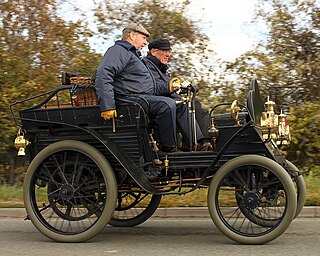
Maxwell was an American automobile manufacturer which ran from 1904 to 1925. The present-day successor to the Maxwell company was Chrysler, now Stellantis North America, which acquired the company in 1925.

A cyclecar was a type of small, lightweight and inexpensive motorized car manufactured in Europe and the United States between 1910 and the early 1920s. The purpose of cyclecars was to fill a gap in the market between the motorcycle and the car. It could accommodate only two passengers, often sitting in tandem.

An overhead valve engine, abbreviated (OHV) and sometimes called a pushrod engine, is a piston engine whose valves are located in the cylinder head above the combustion chamber. This contrasts with flathead engines, where the valves were located below the combustion chamber in the engine block.

Grout Brothers was a manufacturer of steam-powered automobiles in Orange, Massachusetts. The three brothers, Carl, Fred and C.B. were set up in business by their father William L., who had made sewing machines under the New Home name in partnership with Thomas H. White. The early cars were sold under the New Home name.

The Mors automobile factory was an early French car manufacturer. It was one of the first to take part in automobile racing, beginning in 1897, due to the belief of the company founder, Émile Mors, in racing's technical and promotional benefits. By the turn of the century, automobile racing had become largely a contest between Mors and Panhard et Levassor.

The Pungs-Finch was an American automobile manufactured in Detroit, Michigan from 1904 to 1910. They were powerful touring cars built by a factory which primarily made marine gas engines.

In the late 1920s, American automotive company General Motors (GM) launched four companion makes to supplement its existing lineup of five-passenger car brands, or makes. The companion makes were LaSalle, introduced for the 1927 model year to supplement Cadillac; Marquette, introduced in 1929 for 1930 to supplement Buick; Pontiac, introduced for 1926 to supplement Oakland; and Viking, introduced for 1929 to supplement Oldsmobile. GM's fifth existing brand, Chevrolet, did not receive a companion make. With the exception of Viking, each of the companion makes were slotted below their "parent make" in GM's pricing hierarchy.

Luverne was the marque of the Luverne Automobile Company, which produced automobiles from 1904 to 1917 in Luverne, Minnesota.

Marquette was an American automobile manufacturer established by General Motors in 1909 after the purchase of the Rainier Motor Car Company. The Marquette Company did not last long and in 1912 GM announced the company would be closed.

The Hackett was an automobile built in Jackson, Michigan, United States, by the Hackett Motor Car Company from 1916 to 1919.
The Janney was a brass era automobile assembled in Flint, Michigan by the Janney Motor Company in 1906.
The Success Automobile Manufacturing Company was a brass era United States automobile manufacturer, located at 532 De Ballviere Avenue, St. Louis, Missouri, in 1906.

The Jackson Automobile Company was an American Brass Era automobile manufacturer located in and named for Jackson, Michigan. The company produced the Jackson from 1903 to 1923, the 1903 Jaxon steam car and the 1904 Orlo.
Two Brass era automobiles named Richmond were produced in Richmond, Indiana. A Steam car was made by the Richmond Automobile Company in 1902 and 1903. The Wayne Works produced the Richmond automobile from 1904 to 1917.

Walter Lorenzo Marr (1865-1941) was an automotive pioneer and engineer who worked with David Dunbar Buick perfecting the first Buick production automobiles. He worked with Mr. Buick a number of times around the turn of the century, building Buick's first two one-off vehicles. He was the Buick Motor Company's first chief engineer from 1904 through 1918, staying on as consulting engineer until 1923. He was also the founder of the Marr Auto Car Company in 1903 which produced the Marr Auto Car. The Marr Auto Car was one of the world's first automobiles with an overhead camshaft (OHC) engine.

The Sheridan was a brand of American automobile manufactured from 1920 to 1921. Manufacture of the car was based in Muncie, Indiana. The Sheridan nameplate has the distinction of being the first automotive brand started from scratch by General Motors. Prior to the Sheridan, General Motors, under William (Billy) Durant, grew its automotive marques Chevrolet, Oakland, Oldsmobile, Buick and Cadillac, by acquiring independent manufacturers and then folding their operations into the GM structure.

The Sandusky Automobile Company was an automobile manufacturer in Sandusky, Ohio, from 1902 to 1904. It was located at 1114 Camp Street.

The Kessler Motor Company was a short-lived American manufacturer of aircraft engines and automobiles. The brand name for engines and automobiles was Kessler; also Kess-Line for some cars.
Beverly Rae Kimes was an American automotive journalist and historian, known as the "First Lady of Automotive History" and "The Grande Dame of Automobile History". She was born in West Chicago, Illinois on August 17, 1939 and grew up in Wheaton, Illinois. She received a bachelor's degree from the University of Illinois, and a master's degree in journalism from the Pennsylvania State University.

The Buick Six was a top level automobile produced by GM's Buick Division which was first introduced in 1914, and was the senior vehicle to the Buick Series B Four. It was an all new platform which was shared with the Oldsmobile Six and was the first Buick to implement a steering wheel on the left side, and electric starter provided by Delco Remy along with an electric lighting system and electric Klaxon horn. The gearshift and emergency brake were relocated to a central position inside the vehicle, an approach used on all GM products for 1914. It continued to use the patented overhead valve engine implemented by Walter Lorenzo Marr while the cylinder head was not removable until later developments. The engine displacement was 331 cu in (5.4 L) and the wheelbase was 130 in (3,302 mm). The first year Buick Six was only offered as a touring sedan for US$1,985.
















